
Par j 1 and Par j 2, the two major allergens in
Parietaria judaica, bind preferentially to monoacylated
negative lipids
Roberto Gonza
´lez-Rioja
1
, Juan A. Asturias
1
, Alberto Martı
´nez
1
,Fe
´lix M. Gon
˜i
2,3
and
Ana Rosa Viguera
2
1 Research and Development Department, Bial-Arı
´stegui, Bilbao, Spain
2 Unidad de Biofı
´sica, CSIC-UPV ⁄EHU, Leioa, Spain
3 Departamento de Bioquı
´mica, Universidad del Paı
´s Vasco, Leioa, Spain
Plant nonspecific lipid transfer proteins (ns-LTPs) have
been found in a variety of tissues from mono- and
dicotyledonous species [1,2]. Two main families have
been characterized in plants: LTP1 with a molecular
mass of approximately 9 kDa [3] and LTP2 with a
molecular mass of approximately 7 kDa [4]. Their
biological role remains unknown; their function was
initially associated with their in vitro ability to transfer
phospholipids between membranes. On the basis of
this ability, they were assumed to play a role in mem-
brane biogenesis by mediating the transport of lipids
from their site of biosynthesis to other membranes.
The presence of a signal peptide in their sequence, on
the other hand, suggests an extracellular location, and
some studies have highlighted their in vivo role in
pathogen defense reactions and ⁄or responses to
Keywords
cavity volume; CD; lipid binding; lipid
transfer proteins; pyrene fluorescence
Correspondence
A. R. Viguera, Unidad de Biofı
´sica
(CSIC-UPV ⁄EHU), Barrio Sarriena s ⁄n
48940, Leioa, Spain
Fax: +34 946 01 3360
Tel: +34 946 01 3191
E-mail: gbbviria@lg.ehu.es
(Received 5 November 2008, revised
5 January 2009, accepted 19 January 2009)
doi:10.1111/j.1742-4658.2009.06911.x
Par j 1 and Par j 2 proteins are the two major allergens in Parietaria juda-
ica pollen, one of the main causes of allergic diseases in the Mediterranean
area. Each of them contains eight cysteine residues organized in a pattern
identical to that found in plant nonspecific lipid transfer proteins. The
139- and 102-residue recombinant allergens, corresponding respectively to
Par j 1 and Par j 2, refold properly to fully functional forms, whose immu-
nological properties resemble those of the molecules purified from the
natural source. Molecular modeling shows that, despite the lack of exten-
sive primary structure homology with nonspecific lipid transfer proteins,
both allergens contain a hydrophobic cavity suited to accommodate a lipid
ligand. In the present study, we present novel evidence for the formation of
complexes of these natural and recombinant proteins from Parietaria
pollen with lipidic molecules. The dissociation constant of oleyl-lyso-phos-
phatidylcholine is 9.1 ± 1.2 lmfor recombinant Par j 1, whereas pyrene-
dodecanoic acid shows a much higher affinity, with a dissociation constant
of approximately 1 lmfor both recombinant proteins, as well as for the
natural mixture. Lipid binding does not alter the secondary structure con-
tent of the protein but is very efficient in protecting disulfide bonds from
reduction by dithiothreitol. We show that Par j 1 and Par j 2 not only bind
lipids from micellar dispersions, but also are able to extract and transfer
negative phospholipids from bilayers.
Abbreviations
DOPC, 1,2-dioleoyl-sn-glycero-3-phosphocholine; DOPG, 1,2-dioleoyl-sn-glycero-3-phosphoglycerol; LUV, large unilamelar vesicle; ns-LTP,
nonspecific lipid transfer protein; OLPC, 1-oleoyl-2-hydroxy-sn-glycero-3-phosphocholine; rPar j 1, recombinant Par j 1 expressed in
Pichia pastoris; rPar j 2, recombinant Par j 2 expressed in Pichia pastoris;b-py-C
10
-HPC, 1-hexadecanoyl-2-(1-pyrenedecanoyl)-sn-glycero-3-
phosphocholine; b-py-C
10
-HPG, 1-hexadecanoyl-2-(1-pyrenedecanoyl)-sn-glycero-3-phosphoglycerol.
1762 FEBS Journal 276 (2009) 1762–1775 ª2009 The Authors Journal compilation ª2009 FEBS

environmental changes, cutin formation, embryogene-
sis and symbiosis [3,5–8]. Interestingly, Parietaria juda-
ica LTPs have been shown to represent primarily
intracellular proteins that are released from the pollen
grains upon germination [9]. Moreover, it has been
observed that, in some plant species, different isoforms
are expressed differently, suggesting that different types
of ns-LTPs with different tissue specificity (and pre-
sumably different function) may coexist in a given
plant [10]. It appears that ns-LTPs could play a role in
different biological functions through their ability to
bind and ⁄or carry lipophilic compounds. A compari-
son of their biochemical properties reveals several com-
mon characteristics [4]. They are all soluble, relatively
small proteins, and their isoelectric point is, in general,
basic. Furthermore, at the level of primary structure,
they share a pattern of eight cysteines forming four
disulfide bridges, and the tertiary structure is charac-
terized by a single compact domain with four a-helices
and a nonstructured C-terminal coil [11–13].
The identification, isolation and characterization of
proteins responsible for IgE-mediated allergy is a nec-
essary task for improving both the diagnosis and
treatment of this important increasing clinical disor-
der. The knowledge of the biochemical role of novel
allergens can improve the strategy for their purifica-
tion and characterization and, more importantly, it
can help to explain the relationships among biological
function, protein structure and allergenic activity [14].
Unfortunately, a relatively small number of allergens
have been biochemically characterized among the pol-
len allergens. Several members of the plant ns-LTP
family have been identified as relevant allergens in
foods [15]. This allergen family is particularly impor-
tant in the Mediterranean area. In addition to foods,
allergens of the LTP family have also been identified
in other plant sources, such as latex of Hevea brasili-
ensis [16] and some pollens. In the latter, LTPs from
Ambrosia artemisiifolia [17], Olea europaea [18], Arte-
misia vulgaris [19], Arabidopsis thaliana [20], Plat-
anus acerifolia [21] and P. judaica pollens [22,23] have
been described.
Parietaria is a genus of dicotyledonous weeds
belonging to the Urticaceae family. The most common
species are P. judaica and Parietaria officinalis, which
are widely and abundantly distributed in the Mediter-
ranean area, where Parietaria pollen is one of the most
common causes of pollinosis [24]. The two major aller-
gens of P. judaica, Par j 1 and Par j 2, have been
cloned and sequenced, and their recombinant counter-
parts were able to induce histamine release from
basophils of patients allergic to P. judaica pollen in a
way comparable to that of the crude extract from
natural P. judaica [23,24]. Although Par j 1 and Par j 2
display strong sequence divergence with respect to the
ns-LTPs described to date, 3D modeling by homology
suggests that both allergens belong to the ns-LTP pro-
tein family [25,26]. In support of this hypothesis, we
have found significant molecular features of these
modeled Parietaria proteins that are shared by other
members of the family. More importantly, the ability
of these allergens to bind and transfer lipids is demon-
strated in the present study using both natural and
fluorescently labeled ligands.
Results
Molecular model comparison
Previous molecular modeling analysis of Par j 1 and
Par j 2 showed a common 3D structure similar to that
of ns-LTPs [25,26], characterized by an a-helical fold
stabilized by four disulfide bonds [3]. In addition,
experimental assignment of the disulfide bridges in
Par j 2 showed a pattern consistent with this fold [27].
Nevertheless, both Parietaria allergens display low
sequence identity (24–29%) with respect to the
ns-LTPs described to date, as well as larger molecular
sizes (14.7 and 11.3 kDa, respectively). Only residues
relevant from the structural point of view, such as
cysteine, proline and glycine, are completely conserved
in all sequences. Indeed, both Par j 1 and Par j 2 con-
tain eight cysteines that could well be involved in a
similar pattern of four disulfide links (Fig. 1).
Fig. 1. Amino acid sequence alignment of five plant ns-LTPs (barley, wheat, maize, rice and peach), together with Par j 1 and Par j 2. The
C-terminal extensions of Par j proteins are not presented. The conserved residues in all seven proteins are boxed in yellow. Asterisks
denotes residues that interact with lipid in ns-LTP
maize
–palmitate complex (1mzm.pdb).
R. Gonza
´lez-Rioja et al. Two Parietaria allergens behave as ns-LTPs
FEBS Journal 276 (2009) 1762–1775 ª2009 The Authors Journal compilation ª2009 FEBS 1763

One dissimilar overall feature of Par j proteins with
respect to ns-LTPs is the net charge. In general, plant
ns-LTPs are basic proteins (pI 8–10). By contrast,
Par j 1 and Par j 2, although containing many
charged residues (17 positive and 16 negative side
chains for Par j 2 versus eight positive and two nega-
tive side chains for maize ns-LTP), show almost neu-
tral isolectric points. The views of the electrostatic
surface potential reveal an amphipathic overall Par j 1
structure compared to the basic surface of
ns-LTP
maize
(Fig. 2A,B). This seems to be a common
feature of allergens in that they appear to contain
more charged residues compared to their non-allergic
counterparts.
The most relevant structural peculiarity of the
ns-LTP family is the internal cavity that works as the
binding site for different lipidic molecules. In the pres-
ent study, voidoo software was used to calculate the
van der Waals volumes of the hydrophobic cavities
found in the modeled structures. The volume calcu-
lated for the cavity found in Par j 1 is 73 A
˚
3
(Fig. 2E)
and 200 A
˚
3
in Par j 2 (Fig. 2F). Inspection of known
structures shows that a palmitate molecule fills a
600 A
˚
3
cavity in ns-LTP
maize
(1mzm.pdb; Fig. 2D),
and two molecules the same lipid span throughout the
ns-LTP
rice
molecule occupying an open tunnel of
1345 A
˚
3
(1uvb.pdb; Fig. 2H). On the other hand, the
empty cavity of ns-LTP
rice
has 249 A
˚
3
in the unligated
form (1uva.pdb) [28]. Apparently, the volumes of the
filled and empty hydrophobic cavities differ
significantly with respect to several structures. More-
over, ns-LTPs are able to accommodate a wide range
of lipidic ligands with little specificity due to the elas-
ticity of the C-terminal loop (residue numbers 77–92),
which points toward the hydrophobic cavity and
blocks the lipid binding pocket in the free form [28]
(Fig. 2G,H). According to this observation, it can be
inferred that the volume of the empty cavity should
not be critical in discriminating between potential
ligands.
Conversely, residues delineating the cavity in
ns-LTPs could be considered to be the functionally
relevant moieties. Therefore, the character of the side
chains lining the cavities of Par j 1 and Par j 2 could
provide more revealing insights into the proteins func-
tion than the cavity size. An asterisk in Fig. 1 indi-
cates residues contacting the lipid in the ns-LTP
maize
(1mzm.pdb). Most of these residues have a hydropho-
bic nature in all ns-LTPs and also in Par j 1 and
Par j 2 sequences, which is consistent with their
potential function as lipid binding proteins. Although
apolar interactions provide the majority of contacts,
there are two important exceptions in Arg46 and
Tyr81 (number according to maize sequence) that are
present in all the plant ns-LTPs. Both residues form
hydrogen bonds with the carboxylate groups of fatty
acids [29–31] and also act by filling the empty cavity,
shifting significantly after lipid binding. Arg46 is
A
C
E
G
I
B
D
F
H
J
Fig. 2. (A) Electrostatic surface charge potential calculated for
ns-LTP
maize
(1mzl.pdb) and (B) Par j 1. (C) Ribbon diagram of
ns-LTP
maize
complexed with palmitate (1mzm.pdb). Tyr81 and
Arg46 are shown as a ball and stick model. Surface of the cavities
from ns-LTP
maize
–palmitate complex (1mzm.pdb) (D), Par j 1 (E) and
Par j 2 (F) models, unligated ns-LTP
rice
(1rzl.pdb) (G) and ns-LTP
rice
–
(palmitate)
2
complex (1uvc.pdb) (H), and van der Waals surface rep-
resentations of residues facing the cavity of ns-LTP
maize
(I) and
Par j 1 (J). Hydrophobic residues on the surface are shown in
white, polar residues are shown in yellow, negative residues are
shown in red and positive residues are shown in blue.
Two Parietaria allergens behave as ns-LTPs R. Gonza
´lez-Rioja et al.
1764 FEBS Journal 276 (2009) 1762–1775 ª2009 The Authors Journal compilation ª2009 FEBS

found in Par j 1 and substituted by a lysine in
Par j 2, whereas Tyr81 is absent in both Parietaria
sequences. The cavity of maize ns-LTP is highly
polarized and mainly hydrophobic on one side, and
polar and positively charged on the opposite side,
where Arg46 and Tyr81 are located close to each
other (Fig. 2I). This polarization appears to be ideally
suited for an amphipathic negative molecule within
the cavity. Tyr60, the single tyrosine residue found in
Par j 1 sequence does not lie at the polar end as
expected, but at the nonpolar side of the cavity
(Fig. 2J). Moreover, the net charge of the cavity is
neutral due to the presence of Asp37 that compen-
sates the charge of Arg46.
CD
The overall structure of the ns-LTPs known to date
is a four helix bundle with a long C-terminal loop.
To control the correct folding of both proteins after
purification, CD spectroscopy was performed. CD
spectra obtained for the natural mixture were com-
pared with those of individual recombinant Par j 1
and Par j 2 expressed in Pichia pastoris (rPar j 1 and
rPar j 2, respectively). Very similar spectra are
obtained for rPar j 2 and natural Par j 1–Par j 2,
showing a minimum at 208 nm, a well defined shoul-
der at 222 nm, and a maximum at 190 nm. The ratio
of intensities obtained at 222 and 208 nm, however,
are significantly lower than those typical for all-a
proteins, suggesting that bor ⁄and unordered confor-
mations are also present in significant amounts. The
content of a-helix, b-sheet and unordered structure
in Par j 2, as determined by the Fasman protocol
[32], was 47%, 11% and 42%, respectively, in good
aggrement with secondary structure content in the
Par j 2 model; 49 out of 102 residues adopt a helical
conformation. The far-UV CD spectrum of rPar j 1
reveals a higher content in unordered conformations.
Difference spectra of protein molar ellipticities indi-
cate that the 37 extra residues of rPar j 1 are in an
unordered conformation and could account for this
deviation.
Lipid binding assayed through tyrosine intrinsic
fluorescence
Tryptophan fluorescence is frequently used as a means
to test protein conformational changes induced by
unfolding, ligand binding and other protein transitions.
Similarly to plant ns-LTPs, neither rPar j 1, nor
rPar j 2 contain tryptophan residues. Although the
tyrosine fluorescence quantum yield is lower and less
sensitive to environmental changes, in the absence of
tryptophan residues, tyrosine provides an alternative
intrinsic fluorophore. Indeed, Tyr81 (according to the
maize numbering) fluorescence had been previously
used to monitor lipid biding to ns-LTP
maize
[11],
ns-LTP
barley
[33] and ns-LTP
wheat
[30,34,35].
As indicated above, neither Par j 1, nor Par j 2 con-
tain a Tyr residue at the corresponding position. How-
ever, in the model described for Par j 1, Tyr60 is
facing the cavity and, in principle, it can be expected
to be sensitive to lipid binding (Fig. 3). Par j 2 con-
tains two Tyr residues, Tyr101 and Tyr102, that
occupy the last two positions of the sequence. If the
proposed models are correct, and these Parietaria
proteins bind lipids, a saturable transition should be
observed for Par j 1 with the addition of lipid, whereas
Par j 2 fluorescence should remain unchanged.
Figure 4 shows the results obtained for this experi-
ment. The titration was performed with 1-oleoyl-2-
hydroxy-sn-glycero-3-phosphocholine (OLPC) because
this lipid can be suspended in water and does not
cause major changes in sample turbity when added
sequentially to the protein preparation, unlike other
lipids (e.g. oleic acid, also tested in the present study).
Tyrosine fluorescence increased significantly in Par j 1
with the addition of OLPC (scattered light contribu-
tion of the lipid had been subtracted), whereas only
Fig. 3. Ribbon representation of maize ns-LTP structure (1mzl.pdb).
Tyr81 is shown in red stick, whereas Tyr60 of Par j 1 is super-
imposed in green.
R. Gonza
´lez-Rioja et al. Two Parietaria allergens behave as ns-LTPs
FEBS Journal 276 (2009) 1762–1775 ª2009 The Authors Journal compilation ª2009 FEBS 1765

minor changes were observed for the fluorescence cor-
responding to the two remote tyrosine residues in the
Par j 2 sequence. Data could be fitted to a single bind-
ing site using Eqn (1), and an estimated
K
d
= 9.1 ± 1.2 lmwas found for the complex
rPar j 1–OLPC. An identical result was obtained when
Eqn (2) was used for fitting (n= 1).
Lipid binding assayed with a fluorescent
lipid probe
Pyrene is an extrinsic fluorophore that exhibits fluores-
cence emission maxima at 375 and 395 nm (excitation
at 345 nm), attributed to a monomeric pyrene moiety.
In addition, it displays an additional fluorescence emis-
sion peak at longer wavelengths (470 nm), which
occurs only when two pyrene rings reside within 10 A
˚
of each other and form an excited state dimer, usually
called an excimer. In the present study, the fluores-
cence of 1-pyrenedodecanoic acid was monitored for
increasing concentrations of the ligand in the presence
of the Par j proteins. Fluorescence data, measured in
the titration of the two recombinant proteins and the
natural mixture of 0.15 lmprotein in 20 mmsodium
phosphate (pH 7.0), are shown in Fig. 5 (lower panel).
Equation (2) is used to fit (F)F
0
) for calculation of
the K
d
. Very similar values are obtained for the three
proteins: 0.82 ± 0.03 lmfor nPar j 1–Par j 2,
0.76 ±0.03 lmfor rPar j 1 and 1.6 ± 0.06 lmfor
rPar j 2. These K
d
values are comparable to those
calculated for the binding of other ns-LTPs to monoa-
cylated lipids [11] and much lower than the K
d
= 27.9
± 0.03 lmobserved for the binding of 1-pyrenedo-
decanoic acid to ns-LTP
peach
, as also measured in the
present study (Fig. 5A).
Lipid transfer activity
Large unilamelar liposomes (LUVs) preformed with
pure 1-hexadecanoyl-2-(1-pyrenedecanoyl)-sn-glycero-3-
phosphoglycerol (b-py-C
10
-HPG) at 9 lmconcentration
Fig. 4. Tyrosine intrinsic fluorescence data (excitation at 270 nm,
emission at 310 nm) recorded after the addition of increasing
amounts of an aqueous stock solution of OLPC 2 mMto a 1.5 lM
protein (filled circles, Par j 1; open circles, Par j 2) preparation in
20 mMNaCl ⁄P
i
. Contributions of identical additions of lipid in the
absence of protein are subtracted. Lines correspond to data fitting
to Eqn (1).
A
B
Fig. 5. 1-Pyrenedodecanoic acid fluorescence data (excitation at
345 nm emission at 375 nm) for increasing concentrations of the
probe in the presence of ns-LTP
peach
in (A), and the natural mixture
nPar j 1–nPar j 2 (open circles), rPar j 1 (squares) and rPar j 2 (dia-
monds) in (B), at 0.15 lMprotein concentration in 20 mMNaCl ⁄P
i
.
Two Parietaria allergens behave as ns-LTPs R. Gonza
´lez-Rioja et al.
1766 FEBS Journal 276 (2009) 1762–1775 ª2009 The Authors Journal compilation ª2009 FEBS



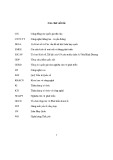

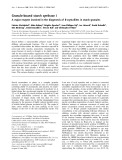

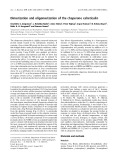
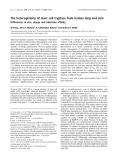
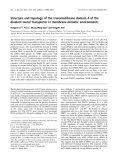
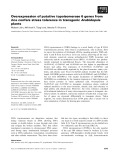





![Báo cáo seminar chuyên ngành Công nghệ hóa học và thực phẩm [Mới nhất]](https://cdn.tailieu.vn/images/document/thumbnail/2025/20250711/hienkelvinzoi@gmail.com/135x160/47051752458701.jpg)









